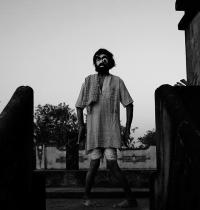Soumya Sankar Bose
Grant Period: Over one year
Soumya Sankar Bose is a young photographer who started his education as an engineer, but then did a Post Graduate diploma in Photography from Pathshala South Asian Media Institute, Dhaka, Bangladesh. He has had group shows in Kolkata and Dhaka and his works have appeared in publications such as Better Photography, Kindle Magazine, Mint Lounge, The Caravan, Wired, and A’int-Bad Magazine as well as online portals such as Gallery Carte Blanche, F-Stop Magazine, Galli Magazine, Scroll.in, The Huffington Post, BBC Online, fltr and Medium. He is the recipient of the TFA-Tasveer Emerging Photographer of the Year Award, 2015.
Jatra is a long standing tradition of a local theatre form in Bengal, often dwelling between folk and urban theatre aesthetics. Although severely challenged by the advent of electronic media more recently, it still retains huge popularity among the rural audience and is a big entertainment industry in the rural parts of Bengal. The form has often played the role of mass educator and has helped building opinions about society, politics and value systems. It has, however, gone through many transformations over time that has changed the economics and aesthetics of the industry. To retain its attraction, traditional Jatra companies have resorted to urban theatrical techniques and opened its door to film stars who are paid disproportionately high remunerations compared to the rest of the cast and crew. While many actors have left the industry and joined other professions for survival, some have succumbed to acute poverty after leaving the industry. Soumya’s current project has a deep connection with his personal and family history and its connection to Jatra. He was born in an extended family of Jatra actors and has witnessed the private lives of the artists as the industry crumbled and shifted.
In this project tentatively titled “Gems of Jatra” Soumya wants to photograph Jatra artists; not to typically document them, but to evoke their association with the characters they played over the years and understand their love for the form. He wants to photograph these artists in their present everyday situations but dressed as their favourite Jatra characters. According to Soumya, this photographic juxtaposition allows them to feel comfortable in the situation while reminiscing about their love of the art form. He travels to their houses and stays with them, talking about their life, their views on society and their understanding of Jatra. In the process, the photographer becomes a part of their reality and they transport themselves into the imaginary realm of the characters played. The photographs that get created as a result of this interaction represent something more than the immediate reality. Everything in the frame is real, yet set up. Albeit the photographs present a documentation of the lives of these artists; but rather than a direct articulation of history, they are artistic representations of memoirs that remain often untold and acutely anecdotal. This project also points to Soumya’s own photographic practice which has its roots in his chronophobia. He fights the condition through photography as well as drawing inspiration from it.
Soumya is planning to photograph at least 50 such artists in various parts of West Bengal. He also wishes to include photographs of objects used by deceased artists as well as Jatra related material from their personal collections. His objective is to develop a comprehensive and contextual picturisation of the Jatra form where his photographs, their life stories, props, décor, costumes from Jatra and archival material contribute to tell a story of Jatra that is seldom foregrounded. This project is supported under the Arts Practice programme because it is asking critical questions about the chronicling of the history of an art form that is going through transformations, while at the same time pushing the boundary of photography itself. It is very difficult to say if his photographs are constructed or real. It would be interesting to know how the engagements of the artists with the photographer informs and influences the aesthetic choices made by him. Soumya is deeply connected to Jatra and has a nostalgic view of the form where he believes that it is dying and must be preserved. But, his project actually challenges his own perspective, questioning the very idea of authenticity of photography and documentation. The evaluator’s reports have pointed this out and Soumya is aware of this.
As an outcome of the project, Soumya wishes to organise an exhibition with the photographs, which will be tentatively held in Chitpur, the Jatra neighbourhood of Kolkata. He already has a few places in mind where it’ll be relevant to host this exhibition. He also wants to invite a few Jatra artists to the exhibition who will talk about their experiences while dressed in costumes and performing the characters they used to play.





